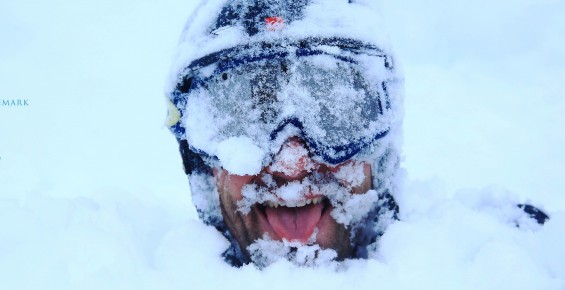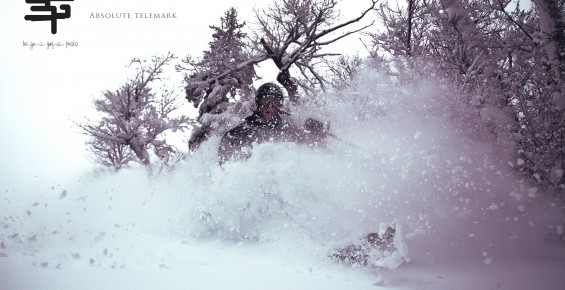Through time, equipment as evolve a lot. From no cable pin binding (here), leather boots (here) and tall skinny skis (here) to rigid cable bindings (here), stiff plastic boots (here) and twice as wide skis (here).
A debate of great matter has emerged of this evolution. Where to mount a telemark binding?
To make a long story short, before parabolic skis, telemark bindings simply used to be mounted at the point of balance of the ski. You took the ski, balanced it on one finger and mount the binding pin (the front of the foot) aligned with that point. Ta dam!. In comparison, alpine skis are mounted by placing the binding at the position that will align the center of the boot sole with the center of side cut.
Then, when parabolic side cut was invented in the mid 90’s, the point of balance didn’t match with the center of side cut anymore. At this point, pin bindings where mounted on the center of the side cut.
But over the past decade, the rigidity of boots and bindings has increased dramatically. It affects the way the back ski reacts to the telemark knee drop while turning. On top of that, parabolic skis are not the first criteria skis are bought today. There’s the camber, the rocker, the side cut, the general flex of the skis, it’s width, tapered tail design… So back to square one, where do we mount the telemark modern telemark binding? It is one of the questions I’m most often asked, even by seasoned telemarkers
I found out that no one agrees on any general rule. I’ve asked top telemark skiers from different categories backgrounds and here’s what they had to say:
Big mountain, Paul Kimbrough:
I always struggle with where to mount my skis and often after mounting and skiing them I decide to remount because I don’t like the original mount. I ski on Moment skis and I tend to like a more symmetrical ski, so my mounts tend to be closer to true center than most telemarkers. With 190cm Bibby Pros, I mount about 5cm back from true center, I think boot center is close to side cut center with this mount, maybe a little back… When mounting I do a lot of eyeballing and usually wing it a bit. Hope that helps.
Cheers
PK
Telemark racer, Mathieu Brunet (represented Canada on telemark world cup):
I’ve been mounting my skis half a inch forward of balance center. But now, with technology improvements, I just mount them according to Alpine standards.
Will Johnston, park builder at Schuss Mountain.
Since I ride Here in the midwest, I ride a TON of park and jumps. I ride bomber bishop bindings, so they have three spots you can mount the binding to the plate. they are mounted ski center to boot center, minus the duck bill. but can move them back up to 25mm.
Tucker Vollbrecht, (see my interview with Tucker to learn more about him)
My bindings are mounted with the boot sole center on the manufacturers center line.
Evans Parent, (see my interview with Evans to learn more about him)
With my NTN setup, I always go boot center to manufacturers center line.
More and more, we tend to see exactly that, boot center to manufacturer’s center line. If you don’t know where to start, definitely try that. After all, telemark is getting closer than it ever has to performance of an alpine setup. Here’s an excellent web site that suggest where to mount your skis, depending on brand and models . But beware, people will still debate on the subject for many years to come…
Myth number 1:
If you change your binding’s position, it will affect the structure of your ski and will make it weaker. Nothing is further from the truth. Skis can be remounted many times and it won’t change anything. As PK says, you can change your mind and re-drill your skis to another change binding position. Just make sure you don’t drill too close to the old holes. And fill up the holes with epoxy.
Myth number 2:
Binding position is crucial. Not so true. You can have them mounted where you think it’s the best and you will probably never see the difference. I’ve seen people mount their bindings up to 20 cm back from center and they could still ski. Although this guy ripped the binding off because it was too far out of the ski’s thickest part. If you don’t go to the extreme, you shouldn’t have any problems.
Myth number 3:
Mounting telemark binding is hard. Well, that’s actually true. Black Diamond Equipment as calculated that the forces on screws are and say:
Among many guidelines, these include using a mandatory 8-10 Nm screw torque with 1-hour epoxy. Alpine binding screw mounting torques (2-3 Nm) are not enough for telemark binding forces. Any less torque than 8-10 Nm does not create enough clamping force to over- come upward binding force. As a result, your screws can loosen, resulting in the binding ripping out.
That’s one reason why most telemark bindings companies now build models with 6 screws. To give you an idea, 3 pins Rotofella have 3 screws. Today’s telemark is creating that much more tension.
Aside from tension, the 90 degree angle of the drill bit is the most significant factor of success to a lasting binding installation.
Myth number 4:
You need the jig to mount a binding. Nah. Most companies will provide a paper template. And if not, a good tech will make a template himself and will be able to mount any binding. It just takes more time.
To have a happy binding setup, you should:
- have your binding mounted by a telemark tech that know what he’s doing
- not have them mounted at you regular ski shop
- mount them yourself only if you’re a proven handyman.
I hope that your half as mixed up as you were before you read that post.
If you are still uncertain, just mount them like Will Johnston recommends (center-to-center minus duckbill)
Don’t forget to subscribe to our free email updates.
Join Absolute Telemark








